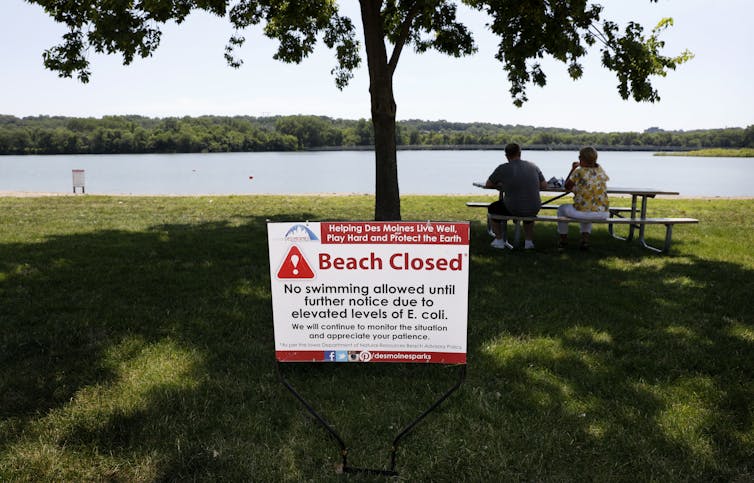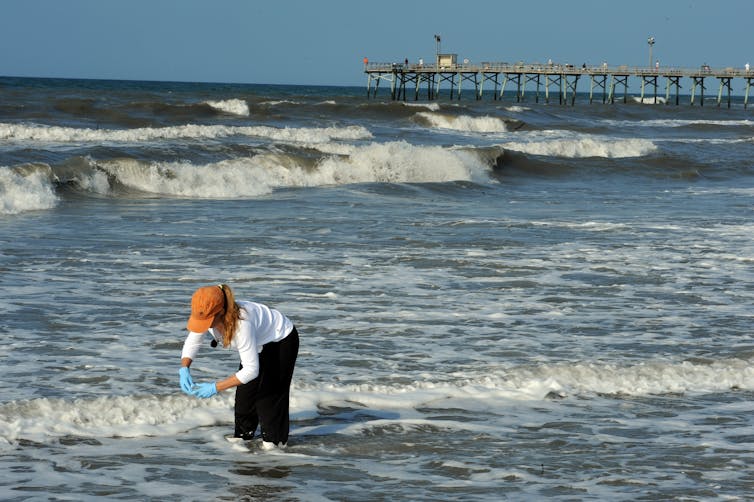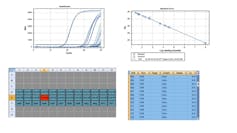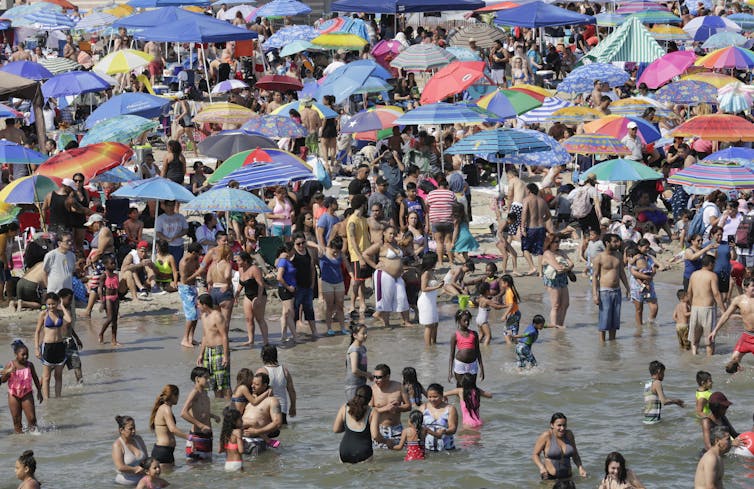Rapid water quality tests better protect beachgoers
- Written by Rachel Noble, Professor of Environmental Sciences and Engineering and Marine Sciences, University of North Carolina at Chapel Hill
Planning a trip to the beach? Along with looking forward to some summer fun, beachgoers may be thinking about the safety of their waterfront destination. Will the water be clean enough for swimming, surfing, wading and all the other ways people enjoy the nation’s shoreline?
Across the United States, county, city and state water quality managers[1] measure levels of indicator bacteria[2] to gauge water quality[3]. When bacteria such as E. coli – used for monitoring freshwater beaches like the Great Lakes – and Enterococcus – used for marine beaches – are present, so might other dangerous bacteria and viruses that are trickier and more expensive to measure.
High levels of the indicator bacteria signal that microorganisms that are a concern to human health, such as Salmonella and norovirus, may also be in the water. Viruses and bacteria that can make you sick sometimes enter beach waters through stormwater runoff, accidental sewage spills[4] and even failing septic systems. When the numbers of E. coli or Enterococcus in water samples from the beach exceed a certain threshold value[5], officials either post a sign advising the public not to swim, or close the beach altogether.
 Elevated levels of indicator bacteria mean troublesome ones might be present too.
AP Photo/Charlie Neibergall[6]
Elevated levels of indicator bacteria mean troublesome ones might be present too.
AP Photo/Charlie Neibergall[6]
The system generally works well, but one serious current drawback is the time it takes to get the results after water samples are collected – nearly 24 hours. This means that if a beachgoer checks the reported water quality at her favorite beach on a Tuesday, the results she sees would be from a water sample collected on Monday morning. Even though water quality is generally good across the nations beaches, tens of thousands of advisories are issued each year[7].
Water quality conditions can change rapidly at beaches because of tides, wind and storms, so 24 hours is a long time for the public to wait for accurate notification. Beach managers are looking for more rapid, cost-effective ways to stay on top of water quality. I’m an environmental microbiologist[8] who’s developed and patented one such solution[9].
 The author collects a water sample in Atlantic Beach, North Carolina.
UNC Chapel Hill
The author collects a water sample in Atlantic Beach, North Carolina.
UNC Chapel Hill
Faster test, quicker results
Here’s how it works. A user collects about a cup of the water of interest, and passes the sample through a filter about the size of a 50-cent piece that captures the bacteria. With the traditional methods, that filter would be placed in a petri dish specially formulated to help bacteria grow. The user would incubate the plate around 20 to 24 hours and then count the bacterial colonies that grew. He or she can then report those final concentrations and give an assessment of whether the water was clean or not – yesterday.
With the newer methods, including the versions I’ve developed, the operator places the same kind of filter in a tube. Instead of waiting for bacteria to grow, she purifies the DNA in the tube and adds a series of chemicals and enzymes. Then a machine performs quantitative polymerase chain reaction, a technique that copies the DNA many times over. Clinical laboratories have widely used this technology for over a decade to rapidly test for bacterial infections, influenza and antibiotic-resistant bacteria.
The qPCR machine heats and cools the sample, allowing the enzymes and chemicals to copy the DNA; one copy of E. coli DNA in the water sample becomes two, then four, then eight, then 16 and so on. Each incorporates a chemical that acts as a fluorescent tag in the new DNA strands. Then the machine can measure how much fluorescence is present in all the copies combined. The greater the fluorescence means more bacteria were in the original water sample.
 Users receive visual read outs of the test results.
Rachel Noble, CC BY-ND[10]
Users receive visual read outs of the test results.
Rachel Noble, CC BY-ND[10]
It only takes about 45 minutes to an hour to make these measurements, and the machine spits out an easy-to-use spreadsheet of the results. Overall, the water quality testing process takes only an hour or two, which is a big time savings.
In 2012, the U.S. Environmental Protection Agency recommended the use of rapid methods[11] for beach water quality testing, but most of the methods released to date have been tedious and complicated. There has been a need to simplify the tests so that the rapid results can go directly to the water quality manager who determines if a beach has exceeded the recommended safety level or not.
Rapid benefits at the beach
Faster results allow the public to be knowledgeable of beach conditions that are more related to the timing of their visit.
Another important advantage is that rapid tests can be used immediately following a storm or accidental sewage overflow event to ensure that the water quality at the beach has returned to normal and recreation can resume.
Quicker results also allow beach managers to understand the conditions that typically drive the water quality at their beaches – things like river flows, stormwater inputs and wind mixing and direction. They can become adept issuing warnings during particular conditions that are frequently dangerous to public health.
Currently, some individual states – including Wisconsin, California and Hawaii – use the rapid methods. Despite the EPA promoting the use of these kinds of rapid tests that rely on analyzing DNA rather than waiting for bacteria to grow, though, their adoption has not been widespread. This is because most of the tests recommended to date have required technical ability and have been relatively expensive.
I’m currently collaborating with private industry[12] to try to make the rapid tests even faster and simpler to use. I’ve developed one rapid test for E. coli that’s good for freshwater beaches. Another version looks for Enterococcus bacteria and is used at marine beaches. Ultimately, my aim is to get these tests to be easily portable. Beach personnel such as lifeguards could do quick water sample collection and analysis, feeding the data by mobile phone to reporting websites.
 Busy beaches have economic benefits.
AP Photo/Bebeto Matthews[13]
Busy beaches have economic benefits.
AP Photo/Bebeto Matthews[13]
Beach water quality has an impact not only on the public, but on businesses dependent on beach visitation such as restaurants, shops, parking, rental vendors and snack bars. The use of the rapid testing approaches to ensure return to good water quality and reopening of a high-use beach with thousands of beachgoers each day can be a boon for beach economics, keeping restaurants and shops open and active.
But most importantly, fast water quality results would reduce the number of illnesses associated with swimming at recreational beaches[14].
References
- ^ state water quality managers (www.michigan.gov)
- ^ levels of indicator bacteria (www.floridahealth.gov)
- ^ gauge water quality (www.waterboards.ca.gov)
- ^ stormwater runoff, accidental sewage spills (www.epa.gov)
- ^ exceed a certain threshold value (www.epa.gov)
- ^ AP Photo/Charlie Neibergall (www.apimages.com)
- ^ tens of thousands of advisories are issued each year (www.nrdc.org)
- ^ I’m an environmental microbiologist (scholar.google.com)
- ^ patented one such solution (patents.google.com)
- ^ CC BY-ND (creativecommons.org)
- ^ recommended the use of rapid methods (www.epa.gov)
- ^ collaborating with private industry (biogx.com)
- ^ AP Photo/Bebeto Matthews (www.apimages.com)
- ^ illnesses associated with swimming at recreational beaches (www.cdc.gov)
Authors: Rachel Noble, Professor of Environmental Sciences and Engineering and Marine Sciences, University of North Carolina at Chapel Hill
Read more http://theconversation.com/rapid-water-quality-tests-better-protect-beachgoers-117136

